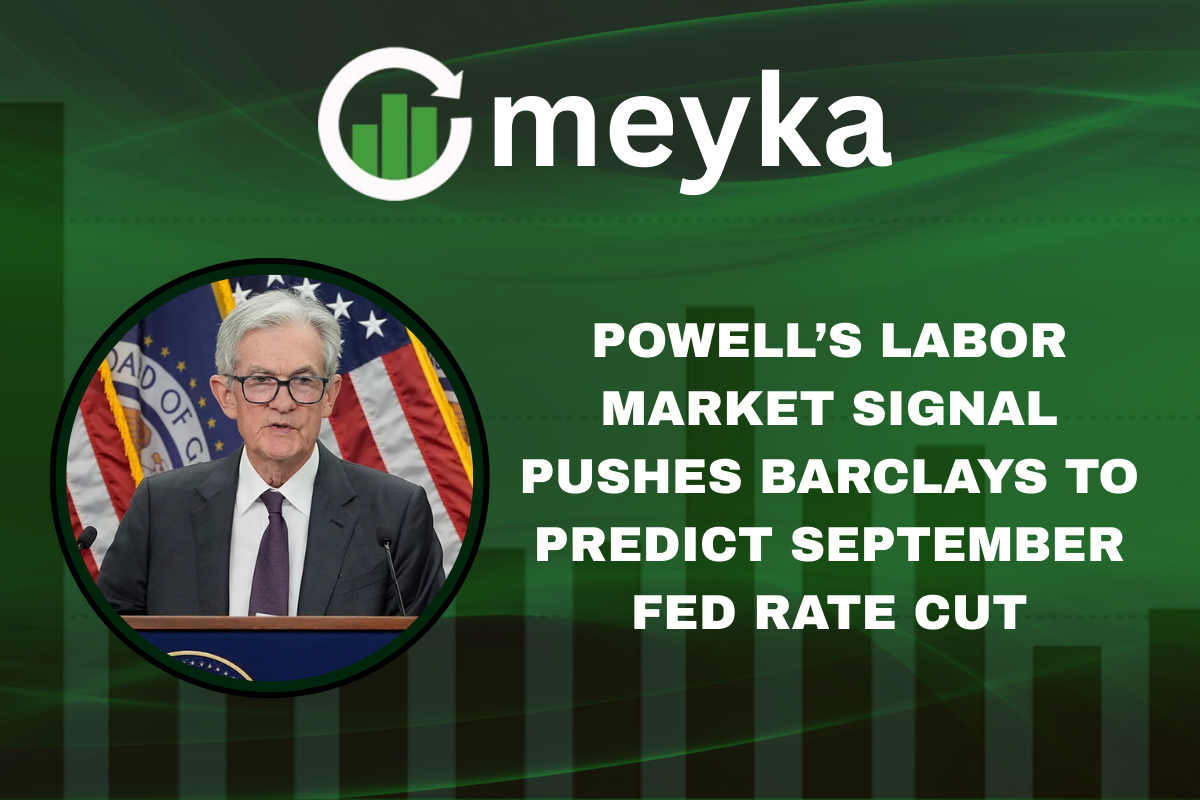Barclays Signals September Fed Rate Cut After Powell’s Labor Market Warning
A Clear Shift Toward Rate Cuts
Barclays, alongside BNP Paribas, has revised its forecast, now expecting the Federal Reserve to implement a 25-basis-point rate cut in September, followed by another in December this year. This represents an important pivot in monetary policy prompted by Fed Chair Jerome Powell’s remarks at the Jackson Hole symposium, where he highlighted growing downside risks to the labor market.
The bank’s new projection indicates a more dovish stance from the Fed than previously anticipated. Analysts note that while inflation remains above target, Powell’s caution on employment suggests the central bank may prioritize supporting jobs over immediate tightening.
Powell’s Labor Market Insights
Why did Barclays adjust its outlook so dramatically? Powell described the labor market as “unusually tight yet fragile,” emphasizing that slowing employment growth and reduced labor supply could amplify risks to the economy. He warned that while inflationary pressures remain a concern, recent economic signals call for careful monitoring rather than aggressive rate hikes.
Economists interpret this as a subtle shift in policy bias, signaling that modest easing may be warranted if labor market weakness persists, even before a formal rate cut is announced. Powell also noted that tariff-related price pressures might be temporary, further supporting a patient approach to monetary adjustments.
What is Barclays’ Updated Forecast
Barclays, led by U.S. economist Marc Giannoni, formally pulled forward its rate cut expectations to September, followed by a second reduction in December. Previously, the bank had only anticipated a December reduction. Despite the shift, Barclays remains cautious about large, aggressive cuts, indicating that “jumbo cuts” are very unlikely this year.
The revised outlook reflects broader market sentiment that Powell’s speech has introduced a new balance between inflation concerns and economic growth risks. Analysts now expect the Fed to adopt a measured, data-driven approach, reacting gradually to labor market trends and inflation indicators.
Market Reaction and Investor Sentiment
Markets responded quickly to Powell’s comments and Barclays’ updated forecast. Futures markets now price in an 87% probability of a September rate cut, up from 75% before Powell’s remarks.
The US dollar weakened, U.S. Treasury yields dropped, and equities rallied globally. Investors welcomed the potential for lower borrowing costs, signaling optimism about sustained economic growth despite labor market caution. Asian markets also experienced gains as capital flowed toward equities in response to the prospect of easier monetary policy.
“Barclays now sees Fed rate cuts in September and December after Powell’s labor market pivot,” noted a finance commentator on X.
What are the Implications for Fed Policy and the Economy?
Powell’s remarks, combined with Barclays’ forecast, indicate a policy shift focused on supporting employment while cautiously managing inflation. If the Fed follows through with two modest cuts, it could ease borrowing costs for businesses and consumers, potentially stimulating investment, spending, and economic activity.
Why is this important? Historically, Fed rate cuts have supported equity markets, corporate expansion, and consumer credit, making the timing and magnitude of cuts critical for investors and businesses alike. Barclays’ forecast suggests that the central bank will proceed gradually, with data-dependent flexibility, rather than aggressive easing.
Broader Economic Impact
The anticipated rate cuts could have ripple effects across the global economy. Lower U.S. interest rates may strengthen emerging markets, enhance capital flows, and reduce the cost of servicing debt. Additionally, sectors sensitive to borrowing costs, such as real estate, technology, and manufacturing, could see improved growth prospects.
While inflation remains a key concern, Powell’s cautious tone reflects a recognition that sluggish job growth could have longer-term consequences, especially for consumer confidence and household spending.
Key Factors to Watch
Investors and analysts will closely monitor upcoming labor and inflation reports, including the August employment data due September 5, for confirmation of Powell’s concerns. The Federal Open Market Committee (FOMC) meeting on September 16–17 will be pivotal in determining whether the Fed will enact the projected cuts.
Markets are now pricing in modest cuts, but any deviation from expectations could create volatility. Barclays emphasizes the importance of gradual adjustments, noting that abrupt policy changes could destabilize markets.
Social Media Reactions
Social media responses highlight the market’s sensitivity to Fed signals. Traders, analysts, and financial commentators shared insights on Twitter, reflecting optimism for easier credit conditions and a cautious approach to labor market risks.
Tweets like the one from @crptAtlas capture the sentiment: “Fed rate cut expectations surge after Powell’s dovish labor signals, Barclays updates outlook”.
Conclusion
Barclays’ forecast for a September rate cut underscores a major recalibration in market expectations. Powell’s remarks about labor market vulnerabilities have shifted sentiment toward a more dovish stance, influencing not only U.S. monetary policy expectations but also global financial markets.
For businesses, investors, and policymakers, the coming months will be critical. Monitoring labor data, inflation trends, and FOMC decisions will be key to understanding how this policy shift unfolds. Gradual, data-driven cuts could provide a much-needed boost to markets, while also supporting economic stability and employment growth.
FAQ’S
Barclays expects a September rate cut after Fed Chair Jerome Powell highlighted labor market risks and slowing employment growth, suggesting the central bank may adopt a more cautious, dovish approach.
Barclays now forecasts two rate cuts in 2025, one in September and a second in December, reflecting concerns over weakening job growth and economic uncertainties.
Potential cuts could ease borrowing costs for consumers and businesses, support investment and spending, and stabilize employment while influencing global capital flows and equity markets.
Markets responded positively, with equities rallying and bond yields declining, as investors priced in an 87% probability of a September cut and welcomed the prospect of lower borrowing costs.
Powell described the labor market as tight but fragile, warning that slower employment growth could pose risks to economic stability, prompting analysts like Barclays to anticipate rate cuts.
Disclaimer
This is for informational purposes only and does not constitute financial advice. Always do your research.






